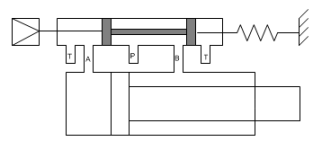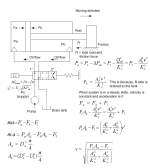Hello experts,
I'm making my first steps in hydraulics and recently I have come across to a very old thread in which the following task was given, but never answered:
http://www.plctalk.net/qanda/showthread.php?t=42533&page=13
Piston: 17"
Rod: 15.5"
Piston weight: 2800 lbs.
Pressure: 1,000 PSI.
No flow controls, simple bang/bang valve, pressure compensated pump.
1. What is the max force that can applied on the blind end of the piston?
2. What is the max force that can be applied to the rod end of the piston?
3. What is the available pressure drop across the bang/bang valve when the piston is extending that dictates maximum flow through the valve?
4. What is the available pressure drop across the bang/bang valve when the piston is retracting?
The question was asked by a forum member TConnolly.
I have made some calculations and would like to verify if I understand the theory correctly.
I assumed given data for Piston and rod are diameter sizes.
1. Max force on blind end of the piston is Fb = 1000 psi*Area of blind end = 1009 kN. Area of blind end is Dp^2*pi/4.
2. Max force on the rod end is: Fr = P*(AreaP-AreadR) = 1000 psi*pi/4*(Dp^2-Dr^2) = 170 kN.
3. Piston is extending. This means pressure on blind end is 1000 psi. The force that corresponds to this pressure is F = p*AreaP = 1009 kN. This force on rod side creates higher pressure since the area is smaller. Prod = F/(AreaP-AreaR) = 2259 PSI. So the pressure drop between rod and blind side of a cylinder is 1259 PSI. Is this correct?
4. When piston is retracting, pressure on the rod side is 1000 psi. This corresponds to a force Fr = P*(AreaP-AreaR) = 446,6 kN. This force is moving the piston, so the pressure created on the blind side is Pb = Fr/AreaP = 442.5 psi. So the pressure drop is 557 psi
Am I on the right track?
Thank you
I'm making my first steps in hydraulics and recently I have come across to a very old thread in which the following task was given, but never answered:
http://www.plctalk.net/qanda/showthread.php?t=42533&page=13
Piston: 17"
Rod: 15.5"
Piston weight: 2800 lbs.
Pressure: 1,000 PSI.
No flow controls, simple bang/bang valve, pressure compensated pump.
1. What is the max force that can applied on the blind end of the piston?
2. What is the max force that can be applied to the rod end of the piston?
3. What is the available pressure drop across the bang/bang valve when the piston is extending that dictates maximum flow through the valve?
4. What is the available pressure drop across the bang/bang valve when the piston is retracting?
The question was asked by a forum member TConnolly.
I have made some calculations and would like to verify if I understand the theory correctly.
I assumed given data for Piston and rod are diameter sizes.
1. Max force on blind end of the piston is Fb = 1000 psi*Area of blind end = 1009 kN. Area of blind end is Dp^2*pi/4.
2. Max force on the rod end is: Fr = P*(AreaP-AreadR) = 1000 psi*pi/4*(Dp^2-Dr^2) = 170 kN.
3. Piston is extending. This means pressure on blind end is 1000 psi. The force that corresponds to this pressure is F = p*AreaP = 1009 kN. This force on rod side creates higher pressure since the area is smaller. Prod = F/(AreaP-AreaR) = 2259 PSI. So the pressure drop between rod and blind side of a cylinder is 1259 PSI. Is this correct?
4. When piston is retracting, pressure on the rod side is 1000 psi. This corresponds to a force Fr = P*(AreaP-AreaR) = 446,6 kN. This force is moving the piston, so the pressure created on the blind side is Pb = Fr/AreaP = 442.5 psi. So the pressure drop is 557 psi
Am I on the right track?
Thank you







